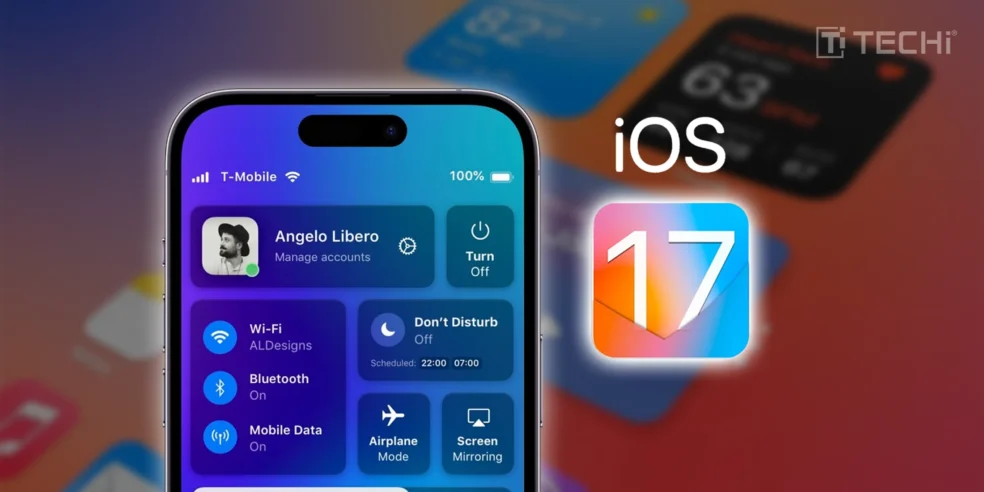Mobile phones have made it easy to connect with our loved ones in just a few clicks. We rely on cell towers for signals and Wi-Fi so we can talk across borders within minutes. But the situation gets worse when the “No Service” bar pops up. We can’t call or text anyone, and our phones suddenly feel useless. If we break down on a dangerous road or hike too far into the mountains, we would be all alone. Mobile phones have made our lives convenient, but the panic of unanswered calls is still real. Thousands of thoughts race through our minds in seconds, and we feel stuck.
But Apple found this problem as a chance to rise. They analyzed this market and brought the idea to message or reach out without a network. People did not believe it at first, but everything changed when Apple introduced Emergency SOS via satellite with the iPhone 14 in 2022. This feature allowed us to send text messages to emergency services even when we lose cell signals. Smartphones already changed how we connect, but emergency SOS via satellite raised the stakes. This was a blessing when people face “dead zones” without reliable cellular coverage in natural disasters.
According to ITU, about 22 % of rural populations in the Americas have no mobile signal at all. An additional 5 per cent only have access to a 2G network, which means that 27 per cent are unable to access the Internet. The GSMA report also shows that mobile broadband still fails to reach 3.45 billion people worldwide. So Apple’s strategy is clear to make it easy for everyone to connect in times of need.
Apple enhanced its satellite features with the iPhone 17 launch. The new model brought Messages via satellite, Find My via satellite, and an improved antenna design to strengthen satellite connectivity.
These enhancements allow us not only to call for help, but also to communicate, locate devices, and stay connected even when cell towers are out of range. We will discuss what improvements Apple has made so far. What has been upgraded and what’s still the same. We will provide a guide to use the iPhone 17 satellite features and will discuss what to expect in the future.
Evolution of Satellite Features on iPhones
Apple introduced Emergency SOS via satellite first with the iPhone 14 in November 2022. It was the first time we were able to text and call someone without a network. But the best thing was that Apple also built in support, which helped us to find our location via Find My satellites. It was the beginning of the biggest change, and Apple started investing in infrastructure. They invested about USD 450 million in ground stations, new antennas, and a partnership with Globalstar to execute this plan. Apple offered this satellite service free for two years from activation on all eligible iPhone 14 models. But it was just the beginning.
Apple expanded satellite services in two main ways with the launch of the iPhone 15 and the iPhone 16. They worked on coverage and a new function. Apple increased the number of supported countries for Emergency SOS via satellite. But everything changed when Apple introduced Roadside Assistance via Satellite in September 2023. This feature helped us to ask for support even when there was no one on the road. Roadside assistance gained popularity, and recently Australia gained access in September 2025.
Apple extended the free trial period for these satellite features on iPhone 14 and iPhone 15 devices. They also announced several extensions, so we might have to pay in mid-2026. But public reactions are mixed on this news. Many people think it’s going to be free forever, and others say it’s unfair to charge. A Reddit user made fun of the subscription plan and shared:
“Imagine the headlines like iPhone User Dies After Being Unable to Access Paywalled Emergency SOS, iPhone Subscription Controversy Turns Fatal, and Apple Accused of Putting Profits Over Lives After Emergency SOS Death.”
Another user responded that “Apple makes some questionable downright stupid decisions, but they aren’t that stupid. But Apple has not revealed any official information about the subscription plans. They are constantly working to improve the features even in iPhone 17. Apple tried to shift the use of satellite features from emergencies to everyday use. They added the Messages via satellite feature to enable iPhone 14 and later models to send and receive texts without a network. They also enhanced Find My via satellite, so people can share their location off the grid more reliably.
Apple has made the satellite system easy to access for everyone. Apple is constantly trying to provide the best service to its customers, and it’s no wonder why we love Apple. Apple’s craze is real, and now many people are expecting satellite connectivity as part of flagship phones. We will see the moves of Apple, and what they will do to fulfill our expectations. But let’s discuss the iPhone 17 satellite features first:
Messages via Satellite
iPhones had serious limitations when used to lose cellular or Wi-Fi service before Messages via Satellite. Although emergency SOS used to help us send messages, it had limitations. We were only able to send emergency messages. But the worst thing was that it was one-way communication. We lacked two-way regular texting, group messages, media sharing, and even reliable latency. We used to reach out to our friends in distress but never received any response from them in return. It was hard to tell if they had read our text or not.
But Apple changed this situation with iPhone 17 and iOS 18. We have an improved Messages via Satellite feature, which helps us send and receive regular texts (iMessage and SMS), emojis, and Tapbacks even without Wi-Fi. It means we no longer have to stress about whether they have read our message or not. A Reddit user shared his story in a thread:
“I’ve been using the IOS beta on my iPhone 14 Pro Max and tested the satellite messaging when we lost one of our friends in Indian Peaks. The messaging worked really well and was pretty reliable.”
Here is how to access the Message via satellite on an iPhone 17:
- Go outside under a clear sky so the phone can see satellites.
- Open the Messages app, compose a new message, and send.
- Hold the phone steady and move as the UI directs until the message is confirmed sent.
- Use short text or the suggested templates for faster delivery.
- Check the message status in the thread to confirm delivery.
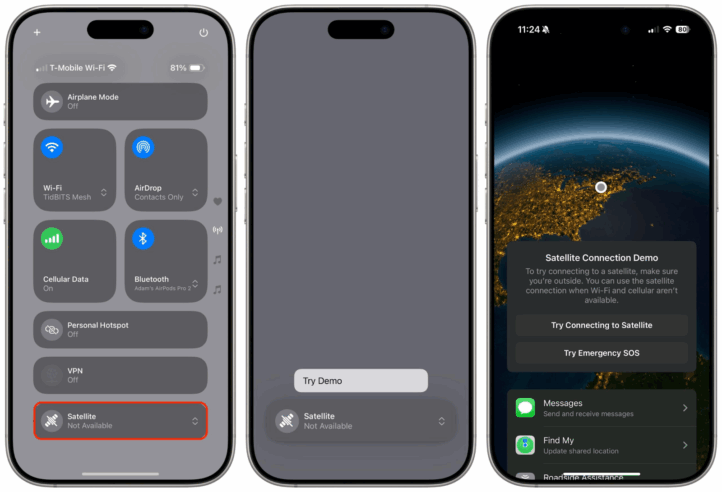
How Messages via Satellite Work?
Many people think about how this system actually works. Does someone read our messages? They are concerned about their privacy but the iPhone has an encrypted system. It automatically alerts us first when we have no signal and offers Messages via Satellite in the Messages app. Messages via satellites are a lifesaver when we find ourselves stuck in remote areas or while hiking, climbing, or camping.
We have to follow the on-screen instructions to connect to a satellite. We see various instructions popping up on our screen. It guides us to a clear view of the sky and horizon. Instructions about avoiding dense foliage, heavy obstructions, and moving left or right also appear. The dynamic connection indicator (e.g., in Dynamic Island on Pro models) tells us how good the signal is.
But Apple compresses text data so we can send text, emojis, and Tapbacks. But there are some restrictions as we cannot send photos, videos, audio messages, group messages, or stickers via satellite. They require a network and messages are light, so they work even at low bandwidth. It takes almost 30 seconds to send a message under clear skies. But they can take over a minute when the weather changes.
Emergency SOS via Satellite
We have used the emergency SOS via Satellite feature of the iPhone 14 since it was launched. Although we got benefits, we came across a few limitations over time. We were not able to do voice calls, and it was only text-based at first. We used to struggle just to find a clear sky in an emergency situation, and it was frustrating. But Apple has improved Emergency SOS via Satellite with the launch of iPhone 17.
They added live video support (Emergency SOS Live Video) through RapidSOS integration. This feature allows rescue teams to see what’s happening with us instead of just a few words of text. They have improved satellite antenna and signal-guidance apps so our devices can better acquire a satellite connection even within obstructions.
Apple cuts down latency by optimizing data compression and improving relay centers. It means our messages are delivered faster, even in bad weather. Emergency SOS via Satellite allows us to send texts to emergency services (911, 112) when we lose cellular coverage. The iPhone also shows a questionnaire to collect our vital information in times of need. These upgrades have made SOS via Satellite more reliable than previous upgrades.
Emergency SOS via satellite saved the life of a 53-year-old mountaineer. He was able to send a distress signal from 10,000 feet on Colorado’s Snowmass Mountain using the satellite messaging capability on his iPhone. This tragedy shows how SOS is a lifesaver, but people are concerned about FCC 911 regulations in the US.
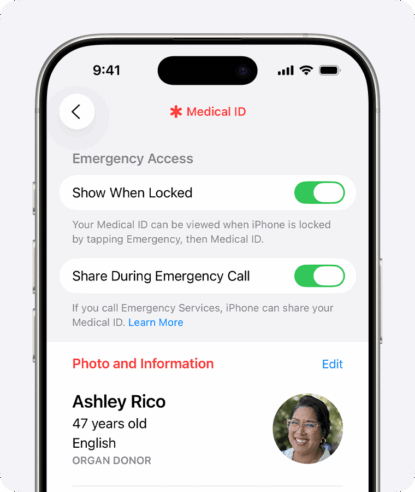
A Reddit user said,
“I wonder if the FCC 911 rule overrides that anyway.”
Another user responded that: “The FCC 911 rule doesn’t apply to sat phones.” So Apple had to build a relay center system. Our SOS message doesn’t go straight to 911. They first reach an Apple-run emergency relay center, where trained staff read our message and then contact the appropriate local dispatchers. Apple supports Emergency SOS via Satellite in the United States, Canada, the UK, France, Germany, Ireland, Austria, Belgium, Italy, Luxembourg, the Netherlands, Portugal, Japan (with iOS 17.6+), Spain, Switzerland, and New Zealand. There are different emergency contact numbers for every country.
How do Emergency Services via Satellite Work?
We need to set up our iPhone first for Emergency SOS via satellite before beginning the trip or any hiking. Make sure to create a Medical ID in the Health app and add your emergency contacts. This step shares our information directly with selected contacts if we try to use SOS.
Our iPhone first tries to call the local emergency number when we lose signal. But if the call does not connect then the switch to satellite text pops up. The system asks us quick questions so we can describe our situation to others for help. We just have to follow the on-screen instructions to connect to the satellite. It automatically shares our location, elevation, battery level, Medical ID, and emergency questionnaire answers with responders after connecting. We may also receive follow-up messages, so we can answer to give more details.
If our emergency contacts have a non-Apple device or don’t have iOS 16.1 or later, they receive a text message that alerts them about your emergency. In the U.S. and Canada, this message comes from the number 767911. In Europe, this message comes from 767112. In Japan, this message comes from 0005990037. The message says,
“You’re receiving this message because someone you know chose you as an emergency contact and used Emergency SOS via satellite.”
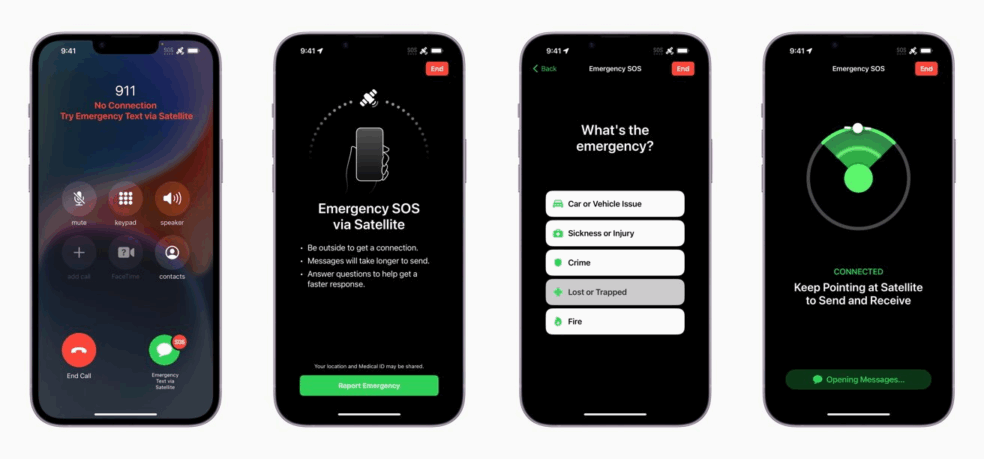
Find My via Satellite
We often find ourselves in places where cell or Wi-Fi coverage disappears. We want to update our loved ones about our location but signals play hide and seek. Although Find My was introduced as part of the iPhone 14 lineup with iOS 16.1 in November 2022, it lacks many functionalities. We could turn on location sharing, but the signal dropped. Nobody knew exactly where we were or how far away help might be. The feature felt too passive, so it never helped us to get reassurance.
But Apple has improved Find My via Satellite with iPhone 17 (and iOS 18 or later). We can now share our location via satellite when we lose cellular coverage. The Find My app shows a Send My Location via Satellite option under the “Me” tab. It helps us connect to a satellite and learn how to point it toward the sky. It provides clear instructions on how to move to clear areas if blocked.
But the best thing is time-based limits. It means we can now share our location every 15 minutes. Users report that Find My via Satellite shares their location when there’s no cellular or Wi-Fi. One Reddit user said:
“It took about 3-5 minutes of holding my phone to the sky, and pointing my iPhone to the sky. It sent my current location to my mom.”
Many people were concerned if someone knew their location, like cybercriminals. But Apple ensures end-to-end encryption for location shares via satellite. It means no one else (not even Apple) can read the precise location data during transit. Apple also linked Find My via Satellite with Safety Check. It helps us to pause sharing our location with people easily.
Safety Check provides a fast way to stop location shares if we feel unsafe or need to restrict who sees us. So no one is going to know about where we are except the ones we share it with. Apple is also Globalstar’s main customer now and has reserved 85% of the network bandwidth for its own use, so we can only assume this is just the start of its expansion into satellite communication services. Here is how to access Find My on iPhone 17:
- Open the Find My app.
- Tap the “Me” tab at the bottom
- Turn on Share My Location
- Tap My Location via Satellite (when no Wi-Fi or cellular is available).
- Follow the on-screen instructions to point your iPhone toward the sky.
- Tap Send My Location via Satellite to share with your chosen contacts.
Roadside Assistance via Satellite
We never ever thought about technology where we can get support even on dangerous roads all alone. Roadside breakdowns happen a lot more often than most of us expect. Almost 69 million vehicle breakdowns occur each year in the U.S. which impacts nearly one in three drivers. These incidents cost the economy billions and leave many people stranded in remote or no-signal areas.
But Apple saves us from that panic. Apple first introduced Roadside Assistance via Satellite with the iPhone 15 in partnership with AAA in the United States. The idea was to help when we break down in areas with no cellular or Wi-Fi coverage. Our iPhone used to connect us to satellites and route our message to roadside assistance providers.
Apple expanded this feature beyond the U.S with the launch of iPhone 17. Apple has partnered with an existing auto club to spread this feature all over the world. These partners already have infrastructure and dispatch systems in place, so it helps respond quickly once the request reaches them.
A tech YouTuber, Brian Tong, decided to test Roadside Assistance via Satellite. He wanted to check if Apple’s claim was right or just fluffy words. He purposely drained his car battery instead of waiting for an accidental breakdown. He used his iPhone to contact AAA through the satellite feature once the vehicle was out of power. The process worked exactly as Apple promised. He typed “Roadside” in Messages and connected to a satellite after following the prompts until AAA received his request for help. An iPhone user also commented on this video:
“My friend who’s been a lifelong Android user recently got the iPhone. He asked me what I do with the phone. I showed him how to test it. Now, he’s going on a hike this coming weekend.”
These reviews show how people are loving this feature, and it actually helps in need. We do not need to be an AAA member to take advantage of Roadside Assistance. They tell us about the charges when we contact them to come out to you. So we can decide either to say yes or no to them..
Request Roadside Assistance via satellite
iPhone 17 uses satellites to connect us with roadside assistance providers when our car breaks down in a place with no cellular or Wi-Fi signal. It has multiple ways to activate this feature, including the connection assistant and the message app. Connection Assistant is available on iOS 18 or later models. We just have to swipe down from the top-right corner in the Control Center to connect with satellites.
You can also access the satellites option through settings and then follow the onscreen steps to connect. There are a few options that pop up in front of us to evaluate the problem, including fuel, tire, and vehicle stuck. We have to click on the issue that we are currently facing to complete the procedure. We can also use Messages directly by opening a new conversation. We have to type “Roadside” in the address field to request roadside assistance via satellite through the pp. But the most important thing to remember is that the Satellite option will not appear in Settings if we still have regular network coverage.
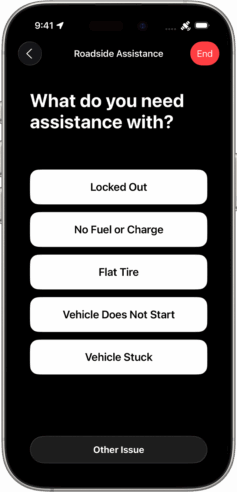
Hardware Satellite Upgrades
Apple made changes in the hardware with the launch of the iPhone 17 Pro model. They moved the antenna lines and radio components around the camera module. The antenna tracks behind the large rear camera bump, which helps avoid obstructions. This repositioning improved signal reception, especially for mmWave 5G, Wi-Fi, and satellite communications. It means we can access the satellite connection faster.
Apple has also reversed the antenna window on the top edge of the iPhone 17 Pro/Pro Max models to allow mmWave signals to pass more efficiently. This design change returns after iPhone 16 removed or modified that window. This upgrade has made it easy to connect even when the weather gets bad.
How to Try the Satellite Connection Demo?
The launch of iPhone 17 has made it easy for us to practice satellite connection before the need arises. They added a demo mode that works like a safe rehearsal. It helps us to learn everything after testing it. We have to step outside into an open area with a clear sky to use the demo. Light tree cover is usually fine, but heavy foliage, tall buildings, or mountain walls can block our signal. Here are the steps that you can follow to test the demo on iPhone 17:
- Swipe down from the top-right corner of your iPhone to open the Control Center.
- Tap the Cellular button, then select Satellite.
- Choose Try Demo to start.
- Pick from trying connecting to the satellite or try emergency SOS.
- Go to Emergency SOS to try the SOS simulation through settings
- Open Messages and then Satellite Connection Demo to see how texting works
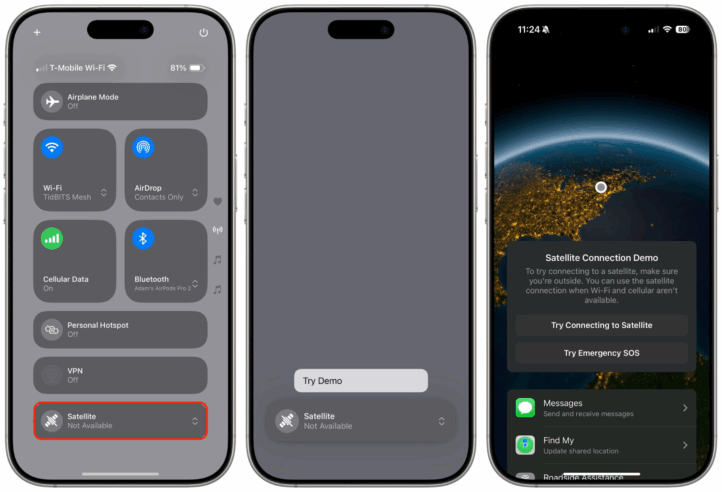
Future of Satellite Voice Calls on iPhone
People often ask if iPhones will ever support regular voice calls via satellite. Although we can now connect to emergency services like 911 through Emergency SOS via Satellite, this isn’t a direct call. Apple routes our information through relay centers, where trained specialists forward the request to emergency responders. So Apple would need much greater bandwidth, stronger antennas, and a stable satellite connection for voice calls.
But Apple is not the one to sit behind. They invested $1.5 billion into its satellite partner Globalstar to expand infrastructure for iPhone’s satellite features. But not everything has been smooth because SpaceX urged the FCC to block Globalstar’s expansion. They argue about fair access to the 1.6GHz and 2.4GHz spectrum bands and partnerships start to shift after this. Starlink and T-Mobile are already testing direct-to-device satellite service, with iPhone and Android support expected in 2025.
Apple has also reportedly held talks with companies like Boeing, EchoStar, and even SpaceX, though Globalstar remains its exclusive partner for now. Apple said its satellite features are “designed to complement carrier offerings, giving users even more ways to stay connected.” Most importantly, Apple said the features have “already helped save lives.”

Although voice calls seem impossible at the moment due to the ongoing conflict. But the most important thing is that T-link has already announced plans to support texting by late 2025 and voice/data by 2026. A Reddit user shared in a thread:
“It won’t always be just texting. T-Mobile announced satellite data will roll out in October 2025, and satellite calls sometime next year.”
Apple’s GlobalStart and SpaceX T-link are competitors. So there is constant pressure on Apple to launch voice calls before them. Apple follows a strategic approach to launch new things. They first introduced simple text, then richer messaging, so now we can expect voice calls. Voice calls via satellite might arrive in the iPhone 18-20 generation if Apple follows that roadmap. It means it’s coming in the next one or two major hardware cycles depending on how quickly Apple and global telecom regulators sort out the challenges.
Privacy & Security of Satellite Features
Privacy becomes an even bigger concern for us when we connect to satellites. What if someone breaches in and tries to read our messages? Digital Trends also warned that Satellite SOS is amazing for emergencies, but it might give some users a false sense of security. But Apple has worked to reduce this risk with the iPhone 17’s satellite features. The system is designed to prioritize our safety and privacy from breaches. But still there are debates about its privacy. Christopher Boyer, the executive director of the National Association for Search and Rescue, said in an interview.
“There will always be a group of novice or untrained outdoor recreation participants that will misplace their trust in the technology as a safety net that they really don’t understand.”
Apple applies compression and encryption to our messages to secure them. Apple says that our SOS messages stay encrypted and decrypted only when they reach Apple’s servers before passing through local emergency services. But they have also highlighted that location sharing in Find My is highly end-to-end encrypted. It means not even Apple can read our location data. This is only in the case of Find My because roadside assistance via satellite shares our location with Apple temporarily. They also share our location with the roadside provider so they can reach us. This location data automatically gets deleted after we get help.
Apple’s approach has helped it build trust with users. It shows that satellite technology can be life-saving without sacrificing privacy. Apple has positioned the iPhone 17 as a safe step toward the future by strengthening the encryption system.
Conclusion
The launch of iPhone 17 has changed what we used to think about Apple. They have shown that satellites are not just for rare emergencies anymore. It’s slowly becoming part of how we stay connected when the signal disappears.
But we cannot deny the truth that there are limitations. We can’t stream videos from a mountaintop or make a full voice call from the middle of the desert. But that day is not too far. Apple is working for a future where our iPhone will never go out of service. These features may feel useless to someone who has signals around 24 hours a day but they are lifelines for hikers and travelers. The possibility of satellite voice calls and even data bursts hints at a future where our iPhones will act as satellite phones.
FAQS
1. Can I make voice calls via satellite now?
No. Currently, you can only send texts or share your location. Voice calling over satellite isn’t available yet.
2. Is it free forever?
No. Apple offers it free for a trial period of two years , but it may become a paid service later.
3. Which iPhones support it?
Satellite features are available on the iPhone 14 and newer models, including the iPhone 17.
4. Does it work everywhere?
No. It only works in selected countries and regions where Apple has coverage agreements.
5. Can I browse the internet with it?
No. Satellite features are limited to text messages and location sharing. They do not support browsing or streaming.
